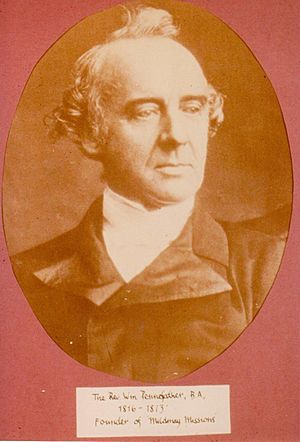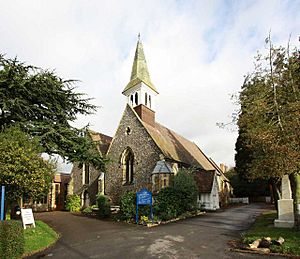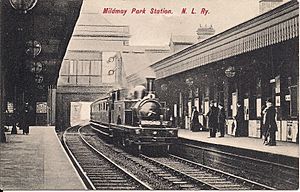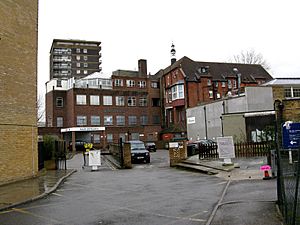William Pennefather facts for kids
Quick facts for kids
William Pennefather
|
|
|---|---|
 |
|
| Born | 1816 Dublin
|
| Died | 1873 |
| Nationality | United Kingdom of Great Britain and Ireland |
| Occupation | cleric |
| Known for | missionary work with Catherine Pennefather |
| Spouse(s) | Catherine Pennefather |
William Pennefather (born 1816, died 1873) was a church leader from Ireland. He spent most of his life working in England. He was well-known for his songs (hymns) and speeches (sermons). He also did important charity work with his wife, Catherine Pennefather. After he passed away, Catherine started many projects in his honor.
Contents
William's Early Life and Education
William was born in Dublin, Ireland. His father, Richard Pennefather, was a respected judge. William was the youngest of their children.
He first went to school in Dublin. Later, he attended a private school near Bristol, England. People there called him "the saintly boy" because he was so good. William often had health problems. Because of this, he studied with a private teacher in Cumbria. In 1834, he started at Trinity College, Dublin. He officially joined the college in 1840, again due to his ongoing health issues.
Starting His Church Career

William became a church minister in 1842. He worked in Ballymacash, near Lisburn, in 1843. The next year, he moved to Mellifont. During the Great Hunger in Ireland, he was very kind. He helped everyone in his area, no matter their religion. After this, he moved to England. He spent the rest of his life working in or near London.
In 1848, he became the leader of Holy Trinity Church in Walton. This was a tough job. The church did not have a house for him, and the pay was low. But William earned the trust and respect of the people there.
Helping People in Barnet
In 1852, William moved to Christ Church, Barnet. He quickly became very influential. For example, one of his church members, Emma Robarts, started the Prayer Union. This group later joined with the YWCA. William's home in Barnet became a meeting place. People from all walks of life came to discuss their faith.
In 1856, he started famous meetings. These meetings focused on different churches working together. They aimed to help people through missionary work. A new train station had just opened nearby. This made it easy for people to visit William. In 1860, he and his wife began training "deaconesses." These women worked like nurses and social workers. This was the first Deaconess Institution in the English-speaking world.
The Mildmay Mission Work
In 1864, the Pennefathers moved to St. Jude's Church, Mildmay Park. Their yearly meetings became known as the Mildmay Conferences. The area around Islington was changing a lot. New homes were built, but many soon became crowded slums. The Pennefathers helped during the cholera outbreak of 1866. They saw it as a chance to help people in their own country.
The organization they started was called the Mildmay Mission. It became very important. It was known as "one of the most influential" groups for helping people at home and abroad. It also led to the creation of many other helpful groups.
Training Deaconesses at Mildmay
The Deaconess Institution trained young women. They learned for two years at Mildmay. They studied theory and practiced helping people. After their training, they went to work full-time. They helped in missions across London and other places. There were usually about 200 deaconesses at one time. They wore a special uniform. This uniform allowed them to work safely in even the toughest areas. Elizabeth Baxter designed these uniforms. She also led the institution for two years, starting in 1866.
The Mildmay Conference Hall
In 1869, the Pennefathers built a large hall at Mildmay. This hall hosted the yearly conferences. It also served as a center for many missionary groups. The Conference Hall was a big building with three stories. It could hold up to 3000 people. Many different groups used it throughout the week. On Sundays, different church groups held services there. Up to 600 men attended its night school.
Mildmay helped start or support many other groups. These included:
- The Dorcas Society: A group that made clothes for charity.
- Caroline Hanbury's project: This group gave flowers to hospitals.
- An orphanage: It trained girls for jobs in homes.
- Mildmay Lads' Institute: This group helped keep boys out of trouble.
- Metropolitan Free Dormitory Association: A homeless shelter that Lord Shaftesbury helped with.
- Children's services: These were inspired by a visit from American speaker Edward Payson Hammond.
The Railway Mission and the Young Women's Christian Association (YWCA) were also based at Mildmay for a time. Mrs. Pennefather helped bring together different groups to form the YWCA.
William's Later Life and Lasting Impact
William continued to hold conferences about missionary work. He died suddenly on April 30, 1873. His efforts to bring different churches together were very important. They helped pave the way for later movements like the Keswick Convention.
Eugene Stock, a leader of the Church Mission Society, called him "the George Mueller of the Church of England." This meant he was a great example of faith and charity.
William Pennefather is remembered as one of the most important preachers of his time. He wrote many hymns (church songs). One of his most famous is "Jesus, Stand Among Us." He also published several books of his sermons.
The Mildmay Conference Hall was taken down in the 1940s. New homes were built on its site.
Today, Mildmay is a charity that helps people with HIV. Its roots go back to William Pennefather and the hospital he helped start. Mildmay Mission Hospital still operates in London. It also does related work in other countries.



